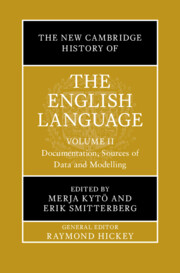Book contents
- The New Cambridge History of the English Language
- The New Cambridge History of the English Language
- The New Cambridge History of the English Language
- Copyright page
- Contents
- Figures
- Tables
- Contributors to Volume II
- General Preface
- Abbreviations for Corpora and Other Electronic Resources
- General Editor’s Introduction
- Introduction to Volume II
- Part I The Textual Record
- Part II Lighthouse Works and Authors
- 14 Beowulf as a Source Text for Archaic Features
- 15 Language Use in Chaucer’s Canterbury Tales
- 16 Shakespeare’s Language
- Part III Genre and Medium in the Record
- Part IV Modelling the Record: Methods and Theories
- Appendix: List of Corpora and Other Electronic Resources
- Index
- References
14 - Beowulf as a Source Text for Archaic Features
from Part II - Lighthouse Works and Authors
Published online by Cambridge University Press: 18 October 2025
- The New Cambridge History of the English Language
- The New Cambridge History of the English Language
- The New Cambridge History of the English Language
- Copyright page
- Contents
- Figures
- Tables
- Contributors to Volume II
- General Preface
- Abbreviations for Corpora and Other Electronic Resources
- General Editor’s Introduction
- Introduction to Volume II
- Part I The Textual Record
- Part II Lighthouse Works and Authors
- 14 Beowulf as a Source Text for Archaic Features
- 15 Language Use in Chaucer’s Canterbury Tales
- 16 Shakespeare’s Language
- Part III Genre and Medium in the Record
- Part IV Modelling the Record: Methods and Theories
- Appendix: List of Corpora and Other Electronic Resources
- Index
- References
Summary
The Old English poem Beowulf is a particularly valuable source of information about early features of the English language. In its present form the poem is recorded in a manuscript of unknown provenance made, in all probability, shortly after the millennium. Yet it evinces linguistic features that are highly conservative, suggesting that the extant text was copied, perhaps directly, from a much older exemplar, and that the poem was composed in a more northerly dialect than the Late West Saxon one in which it is preserved. Some of the poem’s conservative linguistic features are detectable only on the basis of poetic meter. Other of the poem’s archaic features include some that are orthographic in nature: phonological, morphological, syntactic, lexical and metrical. Beowulf is not the only linguistically conservative poem preserved in Old English, but in many ways it reveals, more than any other poem, a great deal about what the language was like at a much earlier time than that at which all but a minuscule portion of the total extant corpus of Old English was recorded. It is thus an invaluable window on the prehistory of the English language.
Information
- Type
- Chapter
- Information
- The New Cambridge History of the English LanguageDocumentation, Sources of Data and Modelling, pp. 359 - 370Publisher: Cambridge University PressPrint publication year: 2025
References
Accessibility standard: WCAG 2.0 A
Why this information is here
This section outlines the accessibility features of this content - including support for screen readers, full keyboard navigation and high-contrast display options. This may not be relevant for you.Accessibility Information
Content Navigation
Allows you to navigate directly to chapters, sections, or non‐text items through a linked table of contents, reducing the need for extensive scrolling.
Provides an interactive index, letting you go straight to where a term or subject appears in the text without manual searching.
Reading Order & Textual Equivalents
You will encounter all content (including footnotes, captions, etc.) in a clear, sequential flow, making it easier to follow with assistive tools like screen readers.
You get concise descriptions (for images, charts, or media clips), ensuring you do not miss crucial information when visual or audio elements are not accessible.
Visual Accessibility
You will still understand key ideas or prompts without relying solely on colour, which is especially helpful if you have colour vision deficiencies.
Structural and Technical Features
You gain clarity from ARIA (Accessible Rich Internet Applications) roles and attributes, as they help assistive technologies interpret how each part of the content functions.
